
Mission-critical refers to the operations that are critical to an organisation's ability to carry out its mission. In other words, mission-critical operations are those operations that are essential to an organisation's ability to perform its intended function.
A mission-critical facility is one that guarantees it will continue to operate, regardless of external conditions. The banking industry is an example of such a facility that must maintain operation 24 hours a day, seven days a week. In fact, a minor interruption in service, or loss of data could seriously impact the operational continuity resulting in economic loss especially during high transaction periods.
* 72% of mission-critical applications experience nine hours of downtime per year2.
* 90% of businesses go bankrupt within two years of a significant failure1.
* The average cost per hour of downtime for a financial brokerage house is estimated at US$65m3.
Of the companies that experience a disaster but have no tested business recovery plans in place, only one in 10 are still in business two years later.
Mission continuity is assured for facilities through the use of redundant power supplies, redundant mechanical systems and state-of-the-art fire protection systems.
This article discusses the smoke detection system and its role in fire prevention and smoke contamination within a mission-critical facility.
The fire risk within today's data centre
Today's computing technology is becoming smaller and therefore requires less space, but the heat being dissipated by the digital hardware is not decreasing, in fact is very high. The result of this high heat load requires significant cooling via the computer room airconditioning (CRAC) system to remove the heat generated within equipment cabinets. Failure to cool this equipment will result in equipment over-heating and provide the potential for a fire.
Mechanical cooling and airflow movement is an essential parameter within the fire detection design and is discussed further in this paper.
The detection strategy
Within a data centre the type of smoke generated and the dynamics of the air-flow creates a challenge for the fire engineer to design an effective fire detection system. It is the detection of smoke that is the most critical part of the fire protection system. Detection systems serve the basic function of alerting occupants within the building of a fire and is used to activate other systems such as mechanical exhaust and fire suppression systems such as water and gas.
The traditional smoke detectors known as early warning smoke detectors (EWSD) or conventional spot type detectors are of ionisation or photoelectric type. Ionisation type detectors were designed to detect very small particles such as the type produced by flammable liquids. Photoelectrical detectors detect larger particles such as those produced by non-natural materials like PVC. Given this fact, photoelectrical detectors are more suitable to detect the fire type we expect within a computer facility, however there are other factors contributing to photoelectric detector's deficiency within these environments.
Within the fire industry, detectors are categorised as early warning smoke detection (EWSD) and very early warning smoke detection (VEWSD). In fact, some people use these terms very loosely and do not differentiate the two correctly. An EWSD system provides detection of a fire condition prior to the time that it becomes threatening to the occupants of a building. Generally, this is the time that smoke is visible. Let us use the example of a paper basket fire within a standard office. Seconds after the paper has ignited, smoke will generate and rise to the ceiling. This visible and hot smoke will eventually enter the smoke detection chamber and trigger the alarm and alert the occupants that a fire has commenced. In contrast, if a computer terminal within the same room had a fault within the electronics resulting in a thermal event, it may smoulder for hours before a flame ignites. We refer to the smouldering stage as the incipient stage to a fire. During this incipient stage the human eye will not see the particles but may smell them. EWSD are not sensitive enough to detect smoke at the incipient stage of an electrical type fire. Only a VEWSD will detect an incipient fire and thus the term 'very early warning'. This stage of a fire could last for hours or even days.
Spot type smoke detectors are 'passive' detectors in that they wait for smoke and rely on the airflow to transport the smoke to the detector. Therefore, their performance is affected by high airflow. Since the rate of smoke generation in a smouldering fire is relatively small, and the airflow velocity in the room is quite high, the movement of smoke is dominated by the airflow of the mechanical systems. Furthermore, the smoke generated during the incipient stage is not hot, therefore there is very little thermal lift restricting smoke movement to the ceiling where spot type detectors are located. In contrast the aspirated smoke detection system is 'active' constantly sampling the air within the environment and therefore is not totally dependent on the thermal energy to transport the smoke to the detector.
Smoke contamination
So why is the detection of smoke at the earliest possible stage important? Because the biggest risk to the continuous operation within a computer room facility is the smoke damage to electrical equipment not the fire. In fact, according to the USA Federal Commission of Communications, 95% of all damage within these facilities is non-thermal.
The by-products of smoke from PVC and digital circuit boards are gases such as HCL and these gases will cause corrosion of IT equipment. The graph below depicts the damage that can be caused by the increase of particulates within the computer room. Even at 16 mg there is moderate corrosion with long-term effects on electronics, at 30 mg the corrosion is active and the effects are short term. Above this the damage to equipment is detrimental to ongoing performance.
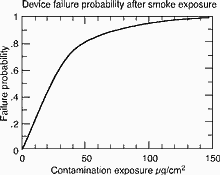
Aspirated smoke detection
Aspirated smoke detection systems are quite different from conventional spot type smoke detectors. Aspirated systems typically comprise a number of small-bore pipes laid out above or below a ceiling in parallel runs, some metres apart. Small holes, also some metres apart, are drilled into each pipe to form a matrix of holes (sampling points), providing an even distribution across the ceiling. Air or smoke is drawn into the pipework through the holes and onward to a very sensitive smoke detector mounted nearby, using the suction pressure of an aspirator (air pump).
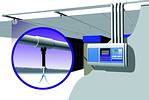
The VESDA aspirated smoke detector is a form of air pollution monitor, which has sensitivity some hundreds of times higher than conventional smoke detectors, yet its false alarm rate is exceptionally low (according to independent surveys). This reliability comes from its high immunity to the major sources of false alarms - dust, draughts and electrical interference. Accordingly, the entire zone is monitored for the early symptoms of overheating materials, possibly hours before a fire develops. This generally allows plenty of time for human intervention, or automatic intervention by the operation of an electric circuit breaker for example (which removes the source of heat - electric current). The primary role of aspirated smoke detection is, therefore, fire prevention.
The following Graph of Smoke Density versus Time illustrates the stage at which VESDA can detect smoke.
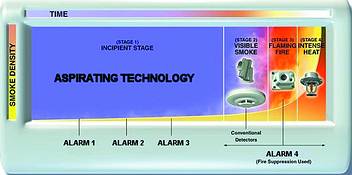
One of the most exciting features of the VESDA System is its flexibility in the setting of its sensitivity. The detector alarm levels can be set from 0,005% obscuration/m to 20% obscuration/m. Obscuration is the effect that smoke has on reducing visibility. Higher concentrations of smoke result in higher obscuration levels, lowering visibility.
The first three levels would be set in the usual manner, with alert set at 0,03%/m, action at 0,06%/m and fire1 at 0,12%/m as typical examples in a relatively clean environment. Then there is the opportunity to set fire2 at 10%/m for example, acting as confirmation of a serious fire event, with the option to activate a suppression system at that point.
The provision of these alarm levels allows for activating an emergency response, for example the Alert Alarm condition may be used to call local staff only to investigate an abnormal condition. Should the smoke condition continue to increase the Action Alarm condition will activate and this may initiate smoke control, begin warning sequence via the Evacuation System and alert further staff members via a paging or SMS to mobile phones. The Fire1 level indicates that a fire condition is very close or has started, at this stage the building is evacuated, the zone on the fire alarm control panel is activated and the signal transmitted to the local monitoring company.
The Fire2 Alarm level will activate once the level of smoke is significant enough to calculate that a fire has started and therefore suppression systems can be activated.
For the first time, one product can provide very early warning as well as initiate suppression at a much later stage. Of course, if building fire systems and procedures have operated correctly, then early intervention should preclude operation of the Fire2 level - but it is a safety net.
How much smoke should we detect?
The obscuration as a unit of measurement has become the standard definition of smoke detector sensitivity used in the industry today. Obscuration is the effect that smoke has on reducing visibility. Higher concentrations of smoke result in higher obscuration levels, lowering visibility.

Tests performed by Vision Fire & Security have shown that by burning a measured length of wire within a controlled room we can determine the resulting obscuration/m. In a 1000 square metre room with a ceiling height of 4,5 m, the insulation from approximately a 480 m length of 18 AWG wire would have to burn to produce 13%/m obscuration throughout the room.
Whereas burning of only a 0,3 m length of the same insulation would produce approximately a 0,0156 obscuration per metre level of smoke throughout this room.
Even this low level is detectable by the VESDA very early warning smoke detection system.
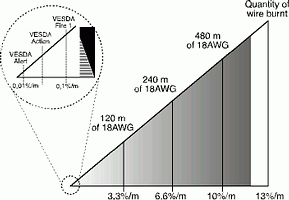
The amount and colour of smoke created in a room during a fire is dependent on the type and amount of material burned. Smouldering combustion of a printed circuit board may produce a heat release rate of one or two kilowatts. By comparison, the heat released from a paper basket fire may be in the range of 15 kW or higher. The fire size to be detected must clearly be less than or equal to 1,0 kW within a data centre if we are to measure the performance of a VEWSD.
Current testing practice within telecommunications and computer rooms today uses a practical on-site test to determine the effectiveness of a fire detection system. In the past, system testing was conducted with a can of smoke that was sprayed into the end of pipe network or into the point detector to determine if the system was working. But this test does not check the system's performance to a real small fire scenario, which is the benchmark for VEWSD.
A common test used today is the BS6266 "Code of Practice for Fire Protection for Electronic Data Processing Installations". This test involves electrically overloading a short length (1 m) of PCV-coated wire which produces a small amount of light grey smoke barely visible and simulates a smouldering fire considerably less than 1,0 kW.
Typically, the test is performed within the room during the commissioning process and the VEWSD should give an alarm indication within 60-120 seconds or whatever the objective for the design.
Theoretically, computational fluid dynamic modelling (CFDM) used by fire engineers to determine the effects of such fires within high-airflow environments should be able to calculate the contamination that results from such fires.
If an assumption is made that any smoke produced is well mixed within the computer room by the high airflow, then a fire engineering analysis can be used to determine the level of contamination (mass of particulate per metre3) for any size of fire. This would be useful in estimating the amount of contamination which IT equipment would be exposed to during various fire conditions. As shown in Graph 1 the contamination exposure caused by fires will increase the probability of IT equipment failure.
Beyond the conventional design techniques
Although the design of fire protection systems has primarily been based on traditional prescriptive fire codes, there is an increasing emphasis on performance-based codes that address individual environment requirements. Performance-based design determines the best fire protection system by assessing the function, risk factors, and internal configuration and conditions of a specific environment.
When designing a fire detection system for very early warning, the designer must consider the following:
1. The airflow characteristics and the air change rate within the room.
2. The coverage area per detector or sample point.
3. The sensitivity required per sampling point.
4. The room size and characteristics - raised floor, tall ceilings etc.
5. The annunciation of emergency response systems.
6. The activation of mechanical control systems such as air extraction and suppression systems.
The detection system must be designed for conditions when the air handling system is on or off. We refer to this concept as primary and secondary smoke detection. Primary detection system - the location where smoke will travel with the CRAC unit on. Secondary detection system - the location where smoke will travel with the CRAC unit off.
The following example describes the primary detection method on the CRAC return air path. This method of VEWSD is suitable for small rooms that use EWSD spot type detectors as the secondary detection system.
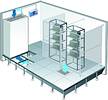
The following example shows the ASD pipe network configured for primary and secondary detection. The sampling pipes on the ceiling and within the floor void are used as secondary detection. The pipe used to detect smoke across the return air path is primary detection. This design method is suitable for rooms where the ceiling height is not tall and the room is a small area.
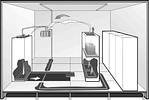
For large rooms with high airflows it is recommended to use a combination of both on-ceiling detection, underfloor detection and return air.
Coverage area
The area coverage of the detector is a very important criterion of the design. This is true from both a performance and cost-effective per-spective.
Below is an illustration of a grid layout for an ASD detector for a 2000 m2 area (this is the maximum area coverage permissible within the codes, BS, AS, NFPA). The sample points for an ASD detector are treated the same as a spot type detector for within most prescriptive codes. You can see below that the area coverage for a sample point is effectively the circle or close to the square around it, which is 10 m x 10 m = 100 m2 (this illustration below is designed as per AS1670 and would be suitable for a low airflow environment). For ASD application in high airflow environments, we can decrease the area coverage for the sample point by adding more holes and making the distance between each pipe less.
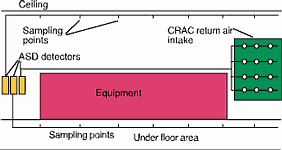
The prescriptive codes and standards today describe detection techniques for on ceiling detection. But new codes such as Draft NFPA 76 'Standard for the Protection of Telecommunication Facilities' is the first code that uses a prescriptive and performance-based approach for the fire protection of telecommunication facilities. Within this code it specifies both the area coverage as well as the sensitivity of the detector. Presently the Draft of the NFPA 76 Standard for the Protection of Telecommunications Facilities document requires that 'Every type of sensor and port installed in a space shall be limited to a maximum coverage area of 200 sq. ft. (reference page 51, section 6-5.3.1.2*) Exception: When (2) levels (high and low) of ports or sensors are provided, each level shall be limited to a coverage of 400 sq. ft. or less per port or sensor.
NFPA 72 'National Fire Code for the USA' recommends the area coverage for spot type detectors to be reduced within high airflow environments to as low as 11,5 m2 per detector for rooms that have 60 air changes per hour.
British Standard - BS 6266 (1992), Section 5.2.5.1 Detector Spacing - General - "From the point of view of automatic fire detection, EDP areas present fire risks quite different from those in many other premises. The concentration of high value equipment, sensitive to damage by even a small fire or smoke, and particularly the high potential consequential losses, make it important to use close spacing of detectors. Detector density should be high enough to enable the smallest fire to be detected quickly without unduly increasing the false alarm risk. A reason for a higher than normal density of detectors is the influence of the airconditioned system, which dilutes the smoke being produced by fire."
Section 5.2.5.2 Point Detectors - "Recommended area coverage per detector for the different location zones are given in Table 1. As follows: EDP equipment room (ceiling height above 3 m), require a maximum spacing of 15-25 square metres (150-250 square feet).
As well as codes there are insurance companies such as Factory Mutual who specify in their Property Loss Prevention Data Sheet (5-48) for Automatic Fire Detectors page 7: "A maximum coverage of 200 sq. ft. (20 m2) per detector may be necessary where room air is changing at a rate of 20 air changes per hour or 100 ft/min (0,5 m/sec).
So the message is that more detectors should be used in high airflow environments to increase the chance of seeing a fire but we should also emphasise the sensitivity of the detector.
Sensitivity of aspirated smoke detection
Although this reduced spacing will increase the probability of smoke being detected, it does not determine if the smoke generated has an obscuration density high enough to trigger an alarm. Therefore, the sensitivity of the system is also fundamental to the design of the VEWSD system.
The sensitivity of the aspirated detection system's sampling point is extremely important to ensure consistent and sensitive detection within the zoned area is achieved. But what codes and standards do not take into account for aspirated smoke detection systems is their ability to use cumulative air sampling within an environment.
Cumulative air sampling refers to the way the aspirated smoke detector samples smoke over the network of sampling points allowing each to contribute to the smoke being sampled at the detector. Within a high airflow environment this phenomena becomes very useful since particles of smoke spread through the room allowing the cumulative sampling effect to take place.
Take the example of a 200 square metre room with 10 sample points on the ceiling. If the detector sensitivity is set to 0,1% obscuration/m this effectively makes each sample point's sensitivity 0,1 x 10 = 1,0% obscuration/m. That is if only one sample point was exposed to smoke it would require 1,0% obscuration/m to trigger an alarm. This is because the fluid mechanics of the model takes into account dilution caused by the other holes.
Using the same example, if smoke enters three holes the effective sensitivity required to trigger an alarm is 0,1 x 10 divided by 3 = 0,33% obscuration/m. So you can see the effect of cumulative detection and how it provides very early warning.
If the same room was designed with EWSD at each detector rated at 5% obscuration/m the alarm would only trigger once the smoke density has reached this point throughout the room or at one detector.
Conclusion
Due to the huge financial loss and potential business risk, a mission-critical facility cannot have any downtime, especially that caused by a fire. As well as fire prevention, it is also the smoke damage that must be prevented because of the detrimental effects it causes to IT and telecommunication equipment. The most important system that contributes to the prevention of fire and smoke damage is a very early warning smoke detection system such as VESDA that meets the performance objective to detect smoke at the very early stage of a fire. The VESDA Aspirated Smoke Detection System provides the designer flexibility by meeting design requirements of prescriptive codes as well as meeting today's performance-based approach. These enabling features include:
* Detection of smouldering fires to large fires.
* Flexibility to design on ceiling, underfloor voids and across return air intakes.
* Multiple alarm levels that can be used to:
- Reliable early warning (to fire wardens, brigades, etc).
- Initiation of staged evacuation.
- Initiation of orderly shutdown of power or air extraction systems.
- Initiation of automatic suppression.
References
1. (Source: Steven R. Christensen and Lawrence L. Schkade, "Financial and Functional Impact of Computer Outages on Business", University of Texas at Arlington).
2. (Source: Standish Group Research, 1998).
3. (Source: Computerworld, August 4, 1997).
4. 2nd International Fire Protection Seminar Buenos Aires 1999 - Telecommunication Facilities.
5. BS6266.
6. NFPA 72, NFPA 76.
7. AS1670.
8. Factory Mutual.
Paul Leslie of Vision Fire & Security can be contacted at Paul.leslie@vision-fs.com

© Technews Publishing (Pty) Ltd. | All Rights Reserved.